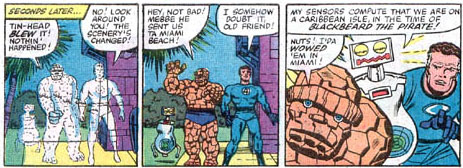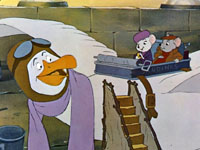Animated Crimes. In 1978, legendary comic book artist Jack Kirby was doing storyboards for The New Fantastic Four show produced by DePatie-Freleng for Saturday morning. Comic book fans were excited because the shows were being written by Stan Lee and storyboarded by Jack, the two men responsible for the creation of the original “Fantastic Four” comic books. Several years later, to celebrate the twentieth anniversary of the “Fantastic Four” comic book (issue #236, November 1981), Marvel Comics took a fourteen page storyboard that Kirby had done for the animated series and had Lee re-dialogue the story, while ten different inkers each got to ink a page. The story was “The Challenge of Dr. Doom”, adapted from Fantastic Four #5 but notably changed to substitute the Human Torch with the robotic H.E.R.B.I.E. because at the time the character of the Human Torch was licensed elsewhere.

At the time, Kirby was not on the best of terms with Marvel Comics because of their failure to return some of his original art, among other items of principle. “I had nothing to do with (the use of the storyboard),” Kirby grumbled in a 1982 interview, “(Marvel) took the roughs I did for DePatie-Freleng and put ten different inkers on it. I didn’t know anything about it until the damn thing was published.” Kirby received no additional remuneration for the reuse of the storyboard.
Career Advice. John McCrory in the March 26, 1927 issue of “Motion Picture World” magazine gave this advice to the readers: “A movie cartoonist has to be more than a little bit crazy, he must in most cases be a raving maniac … God only knows what a vast number of things a movie cartoonist has to study and observe before he can do his day’s work. In fact, everything from how a snake makes love, to cooking a Spanish omelet in an Irish restaurant. It is not unusual in a cartoon to see several artists doing high dives off their desks, or playing leap frog, maybe doing a dry swim on the floor while several others stand by and watch to study the timing of the action.”
Animated Films That Never Were. In 1994, it was announced that veteran television writer and director Stan Daniels (“Taxi” tv series) would write the script adaptation for Amblin Entertainment’s animated feature version of the musical “Carnival” which would be produced by Steven Spielberg and would include music from the original score.
Dueling King Kongs. To take advantage of the release in 1976 of the Dino de Laurentiis live action movie, “King Kong”, two animation studios announced Kong animated series. Fred Calvert, president of Farmhouse Films, announced that he was preparing a six part animated adaptation of the famous story for Saturday morning. Calvert based his effort on the ruling that original novel was in public domain due to improper copyright renewal. DePatie-Freleng Enterterprises the very same month stated they had joined forces with producers Walter Bien and Gene Farmer to develop an animated series based on the character. Neither project was completed.
 Too Scary. Tim Curry auditioned for the part of Judge Doom in “Who Framed Roger Rabbit” (1988). He didn’t get it because his performance scared Steven Spielberg and Michael Eisner.
Too Scary. Tim Curry auditioned for the part of Judge Doom in “Who Framed Roger Rabbit” (1988). He didn’t get it because his performance scared Steven Spielberg and Michael Eisner.
Too Dark. Disney’s first attempt at an adaptation of Margery Sharp’s “The Rescuers” in the early 1960s didn’t meet with Walt’s approval. At the time, the story had the mice rescuing a poet who had been imprisoned unfairly for political reasons. Walt said he thought the story was too “dark” so the project was shelved and then later reworked. Walt also felt the original approach by storyman Bill Peet to Rudyard Kipling’s “The Jungle Book” was too “dark” and went so far as to compare the darkness in tone to Batman comic book stories.
Transportation Problems. In the 1987 animated film “G.I. Joe: The Movie”, the Sgt. Slaughter character was inspired by the real wrestling personality. When he saw the script for the movie, the wrestler was extremely disappointed that his personal tank got blown up. Writer Buzz Dixon had to calm down the intimidating fellow by assuring him that they would do some rewriting so that he would get another tank.
Family Resemblance. Actress Paige O’Hara, who provided the voice for Belle in Disney’s “Beauty and the Beast”, told me in 1992 that one of the questions she often got asked was how close she was to her animated counterpart. “Some people think I look a lot like her, and some don’t think I do at all,” she laughed. “We have similar coloring, and she definitely has some of my expressions. When Belle pulls her hair out of her face, and when she looks at the Beast with that questioning ‘Are you for real?’ look, those are definitely things I do.
One Man’s Garbage. When actor Leslie Nielsen was working at the Disney Studios on the “Swamp Fox” series (1959-1961), he remembered walking by the trash bins outside the sound stages. Inside the bins, he saw “these wonderful hand-drawn sequences on celluloid. I remember looking at them and thinking about how lovely they were, but it never occurred to me to pick up a handful or so. It wasn’t there to help yourself. It was garbage!”
Voice Problems. Actor Tommy Steele, who had appeared in the Disney live action film “The Happiest Millionaire” (1967), was originally to have voiced the resourceful fox in Disney’s animated feature “Robin Hood” (1971) but his regular commitments conflicted with the recording sessions scheduled by Disney so actor Brian Bedford got the part instead.
Cat Caper. When cartoonist Walt Kelly was working on the television animated special, “Pogo’s Special Birthday Special” (1969), he stayed at the Roosevelt Hotel in Hollywood, California. The executive manager of the hotel had a cute cat and Kelly used the feline as inspiration for a new character he introduced into the Sunday “Pogo” comic strip at the time.
 Toon Temp. What does Barney Rubble of “The Flintstones” do for a living? Most fans just assume he works with Fred Flintstone at the rock quarry. However, the series was loosely based on “The Honeymooners” and those two characters worked at different jobs. According to producer Joe Barbera in a statement when the live action “The Flintstones” film came out in 1994, “It was convenient not to have him in a set thing. Full time work never seemed necessary but whenever we wanted to give him a job, we did.” Barbera went on to say that his favorite job for Barney was “bumbling detective”.
Toon Temp. What does Barney Rubble of “The Flintstones” do for a living? Most fans just assume he works with Fred Flintstone at the rock quarry. However, the series was loosely based on “The Honeymooners” and those two characters worked at different jobs. According to producer Joe Barbera in a statement when the live action “The Flintstones” film came out in 1994, “It was convenient not to have him in a set thing. Full time work never seemed necessary but whenever we wanted to give him a job, we did.” Barbera went on to say that his favorite job for Barney was “bumbling detective”.


 Jim Korkis is an internationally respected animation historian who in recent years has devoted his attention to the many worlds of Disney. He was a columnist for a variety of animation magazines. With his former writing partner, John Cawley, he authored several animation related books including The Encyclopedia of Cartoon Superstars, How to Create Animation, Cartoon Confidential and Get Animated’s Animation Art Buyer’s Guide. He taught animation classes at the Disney Institute in Florida as well as instructing classes on acting and animation history for Disney Feature Animation: Florida.
Jim Korkis is an internationally respected animation historian who in recent years has devoted his attention to the many worlds of Disney. He was a columnist for a variety of animation magazines. With his former writing partner, John Cawley, he authored several animation related books including The Encyclopedia of Cartoon Superstars, How to Create Animation, Cartoon Confidential and Get Animated’s Animation Art Buyer’s Guide. He taught animation classes at the Disney Institute in Florida as well as instructing classes on acting and animation history for Disney Feature Animation: Florida.




















































Would have loved to have seen that Tim Curry Judge Doom audition!!!
Shame that Leslie Nielsen never thought twice about that ‘garbage’ as I would.
“Most fans just assume he works with Fred Flintstone at the rock quarry.”
There are some Flintstone spin-offs that often stick Barney there I noticed.
H-B specifically made Barney not a co-worker of Fred in one Season 3 episode set-up, in order to have him fired and then hired at the quarry when Mr. Slate finds out they’re related. It’s not until you get to the Saturday morning Pebbles & Bam Bam Show that they’re both working together (which at least could be explained by the fact it was supposed to be 15 or so years after the original show, when the kids are now car-driving teenagers — but it stuck in later versions, when P&BB went back to being toddlers).
The last panel of the tweaked Kirby layout with Herbie looks like some sort of Marvel “Draw Your Own Comic Book Character” contest Stan would have put into some cross-promotion deal with Highlights for Children or My Weekly Reader. H.E.R.B.I.E. definitely doesn’t fit the overall layout.
Maybe if Barney had a steady job, he wouldn’t always be trying to steal Fred’s Fruity and Cocoa Pebbles cereal all the time…
I would love to hear the Tim Curry audition tapes for Roger Rabbit and Batman TAS (he auditioned for The Joker, where apparently he was ALSO deemed too scary). This kind of stuff always fascinates me- the “what could have been” mentality.